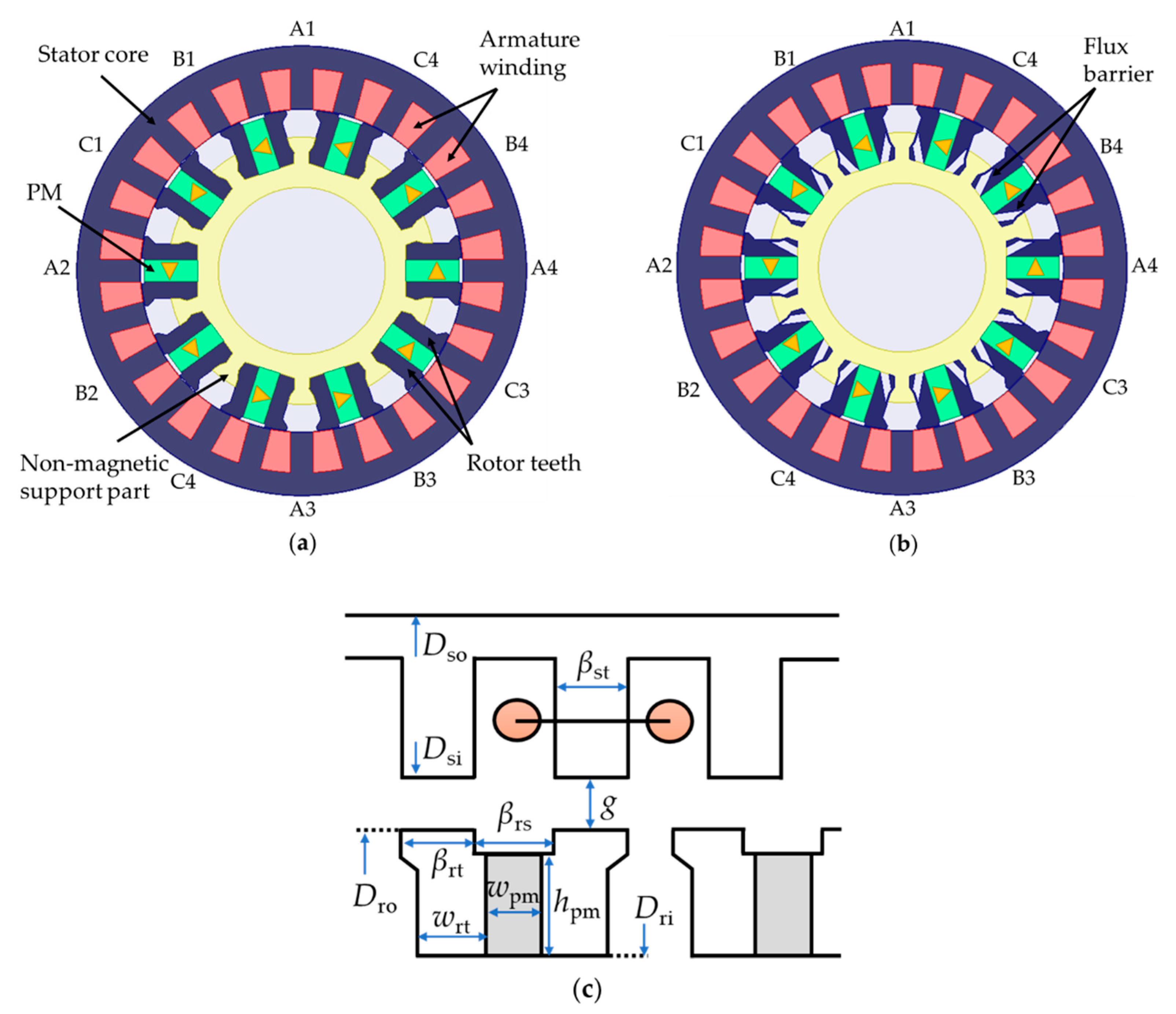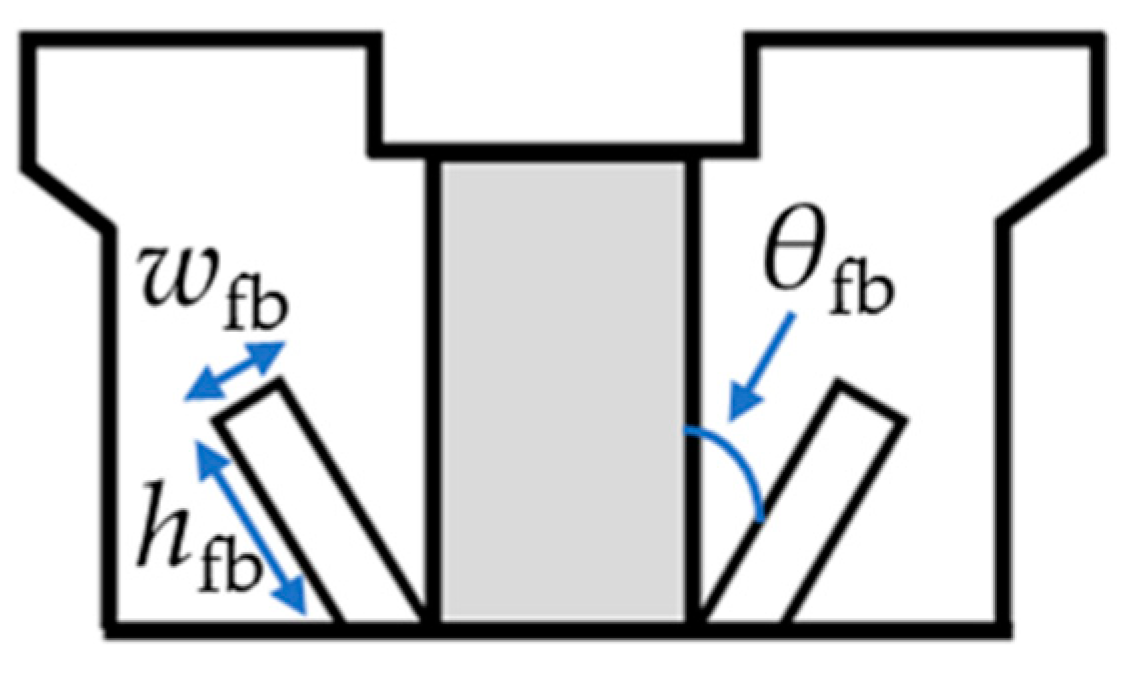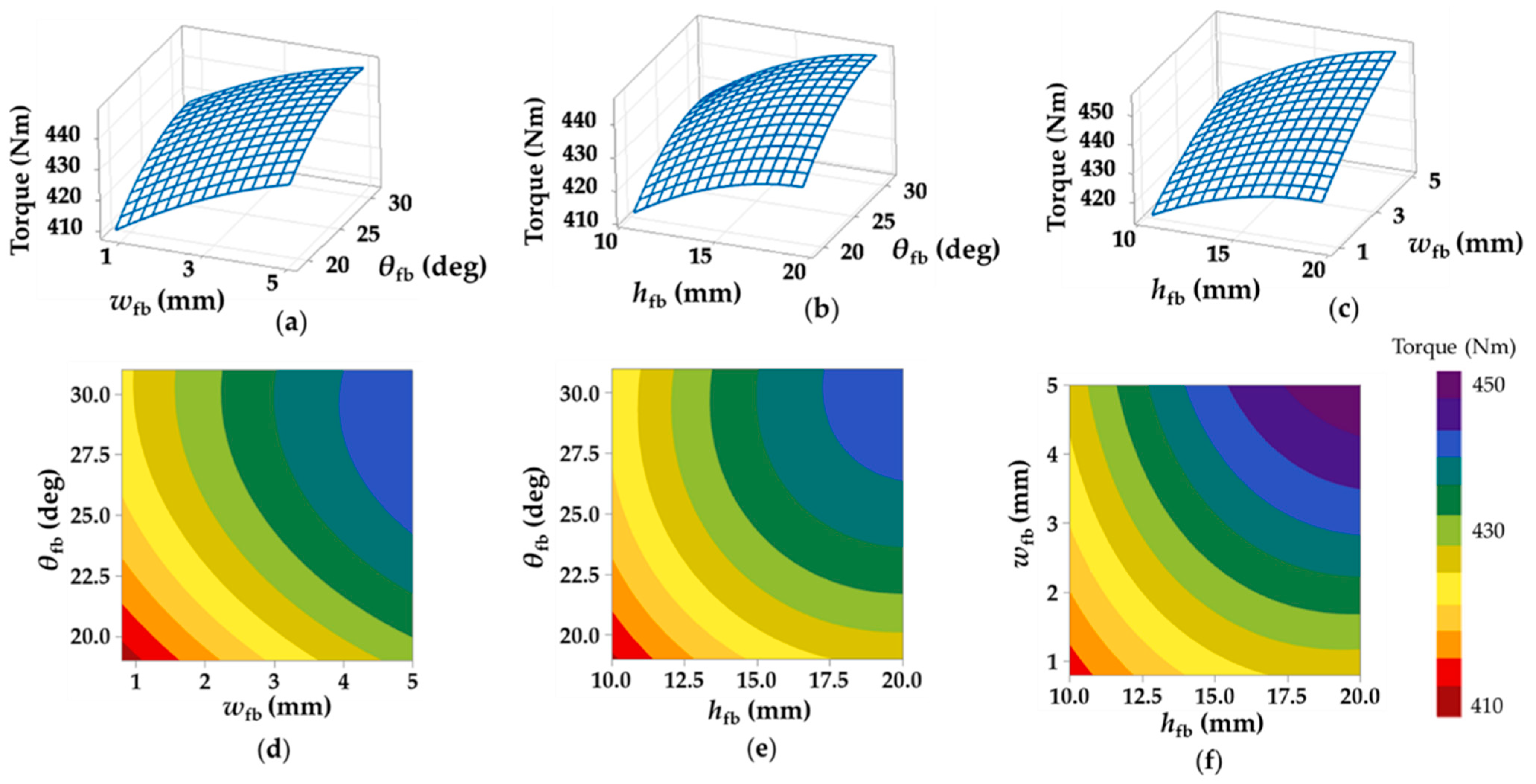Modeling and Optimal Configuration Design of Flux-Barrier for Torque Improvement of Rotor Flux Switching Permanent Magnet Machine
Abstract
:1. Introduction
2. Machine Topology and Working Principle
3. Flux Barrier Design and Optimization
3.1. Flux Barrier Design
3.2. Optimization of Flux Barrier Geometry Using RS Methodology
4. Performance Evaluation
4.1. No-Load Performance
4.2. Air-Gap Flux Density
4.3. On-Load Torque Performance
4.4. Losses Analysis and Efficiency
5. Conclusions
Author Contributions
Funding
Data Availability Statement
Conflicts of Interest
References
- Chau, K.T.; Chan, C.C.; Liu, C. Overview of Permanent-Magnet Brushless Drives for Electric and Hybrid Electric Vehicles. IEEE Trans. Ind. Electron. 2008, 55, 2246–2257. [Google Scholar] [CrossRef] [Green Version]
- Belkhier, Y.; Shaw, R.N.; Bures, M.; Islam, M.R.; Bajaj, M.; Albalawi, F.; Alqurashi, A.; Ghoneim, S.S. Robust Interconnection and Damping Assignment Energy-Based Control for a Permanent Magnet Synchronous Motor Using High Order Sliding Mode Approach and Nonlinear Observer. Energy Rep. 2022, 8, 1731–1740. [Google Scholar] [CrossRef]
- Cheng, M.; Hua, W.; Zhang, J.; Zhao, W. Overview of Stator-Permanent Magnet Brushless Machines. IEEE Trans. Ind. Electron. 2011, 58, 5087–5101. [Google Scholar] [CrossRef]
- Lounthavong, V.; Sriwannarat, W.; Siritaratiwat, A.; Khunkitti, P. Optimal Stator Design of Doubly Salient Permanent Magnet Generator for Enhancing the Electromagnetic Performance. Energies 2019, 12, 3201. [Google Scholar] [CrossRef] [Green Version]
- Sriwannarat, W.; Khunkitti, P.; Janon, A.; Siritaratiwat, A. An Improvement of Magnetic Flux Linkage in Electrical Generator Using the Novel Permanent Magnet Arrangement. Acta Phys. Pol. A 2018, 133, 642–644. [Google Scholar] [CrossRef]
- Sriwannarat, W.; Seangwong, P.; Lounthavong, V.; Khunkitti, S.; Siritaratiwat, A.; Khunkitti, P. An Improvement of Output Power in Doubly Salient Permanent Magnet Generator Using Pole Configuration Adjustment. Energies 2020, 13, 4588. [Google Scholar] [CrossRef]
- Sriwannarat, W.; Siritaratiwat, A.; Khunkitti, P. Structural Design of Partitioned Stator Doubly Salient Permanent Magnet Generator for Power Output Improvement. Adv. Mater. Sci. Eng. 2019, 2019, 2189761. [Google Scholar] [CrossRef] [Green Version]
- Zhu, Z.Q.; Chen, J.T. Advanced Flux-Switching Permanent Magnet Brushless Machines. IEEE Trans. Magn. 2010, 46, 1447–1453. [Google Scholar] [CrossRef]
- Thomas, A.S.; Zhu, Z.Q.; Jewell, G.W. Comparison of Flux Switching and Surface Mounted Permanent Magnet Generators for High-Speed Applications. IET Electr. Syst. Transp. 2011, 1, 111–116. [Google Scholar] [CrossRef]
- Shi, Y.; Jian, L.; Wei, J.; Shao, Z.; Li, W.; Chan, C.C. A New Perspective on the Operating Principle of Flux-Switching Permanent-Magnet Machines. IEEE Trans. Ind. Electron. 2015, 63, 1425–1437. [Google Scholar] [CrossRef]
- Shao, L.; Hua, W.; Zhu, Z.Q.; Tong, M.; Zhao, G.; Yin, F.; Wu, Z.; Cheng, M. Influence of Rotor-Pole Number on Electromagnetic Performance in 12-Phase Redundant Switched Flux Permanent Magnet Machines for Wind Power Generation. IEEE Trans. Ind. Appl. 2017, 53, 3305–3316. [Google Scholar] [CrossRef]
- Su, P.; Hua, W. Performance Comparison between Rotor Flux-Switching and Stator Flux-Switching Machines Considering Local Demagnetization. AIP Adv. 2017, 7, 056641. [Google Scholar] [CrossRef] [Green Version]
- Su, P.; Hua, W.; Wu, Z.; Chen, Z.; Zhang, G.; Cheng, M. Comprehensive Comparison of Rotor Permanent Magnet and Stator Permanent Magnet Flux-Switching Machines. IEEE Trans. Ind. Electron. 2018, 66, 5862–5871. [Google Scholar] [CrossRef]
- Su, P.; Hua, W.; Wu, Z.; Han, P.; Cheng, M. Analysis of the Operation Principle for Rotor-Permanent-Magnet Flux-Switching Machines. IEEE Trans. Ind. Electron. 2017, 65, 1062–1073. [Google Scholar] [CrossRef]
- Su, P.; Hua, W.; Hu, M.; Chen, Z.; Cheng, M.; Wang, W. Analysis of PM Eddy Current Loss in Rotor-PM and Stator-PM Flux-Switching Machines by Air-Gap Field Modulation Theory. IEEE Trans. Ind. Electron. 2019, 67, 1824–1835. [Google Scholar] [CrossRef]
- Su, P.; Hua, W.; Hu, M.; Wu, Z.; Si, J.; Chen, Z.; Cheng, M. Analysis of Stator Slots and Rotor Pole Pairs Combinations of Rotor-Permanent Magnet Flux-Switching Machines. IEEE Trans. Ind. Electron. 2019, 67, 906–918. [Google Scholar] [CrossRef]
- Eduku, S.; Chen, Q.; Xu, G.; Liu, G.; Liao, J.; Zhang, X. A New Fault-Tolerant Rotor Permanent Magnet Flux-Switching Motor. IEEE Trans. Transp. Electrif. 2022, 8, 3606–3617. [Google Scholar] [CrossRef]
- Su, P.; Hua, W.; Zhang, G.; Chen, Z.; Cheng, M. Analysis and Evaluation of Novel Rotor Permanent Magnet Flux-Switching Machine for EV and HEV Applications. IET Electr. Power Appl. 2017, 11, 1610–1618. [Google Scholar] [CrossRef]
- Sanada, M.; Hiramoto, K.; Morimoto, S.; Takeda, Y. Torque Ripple Improvement for Synchronous Reluctance Motor Using an Asymmetric Flux Barrier Arrangement. IEEE Trans. Ind. Appl. 2004, 40, 1076–1082. [Google Scholar] [CrossRef]
- Barcaro, M.; Bianchi, N.; Magnussen, F. Rotor Flux-Barrier Geometry Design to Reduce Stator Iron Losses in Synchronous IPM Motors under FW Operations. IEEE Trans. Ind. Appl. 2010, 46, 1950–1958. [Google Scholar] [CrossRef]
- Yamazaki, K.; Kumagai, M.; Ikemi, T.; Ohki, S. A Novel Rotor Design of Interior Permanent-Magnet Synchronous Motors to Cope with Both Maximum Torque and Iron-Loss Reduction. IEEE Trans. Ind. Appl. 2013, 49, 2478–2486. [Google Scholar] [CrossRef]
- Zhao, W.; Zhao, F.; Lipo, T.A.; Kwon, B.-I. Optimal Design of a Novel V-Type Interior Permanent Magnet Motor with Assisted Barriers for the Improvement of Torque Characteristics. IEEE Trans. Magn. 2014, 50, 8104504. [Google Scholar] [CrossRef]
- Sarani, E.; Vaez-Zadeh, S. Line Start Permanent Magnet Motors with Double-Barrier Configuration for Magnet Conservation and Performance Improvement. IET Electr. Power Appl. 2017, 11, 1656–1663. [Google Scholar] [CrossRef]
- Yamazaki, K.; Kato, Y.; Ikemi, T.; Ohki, S. Reduction of Rotor Losses in Multilayer Interior Permanent-Magnet Synchronous Motors by Introducing Novel Topology of Rotor Flux Barriers. IEEE Trans. Ind. Appl. 2014, 50, 3185–3193. [Google Scholar] [CrossRef]
- Choi, G.; Jahns, T.M. Reduction of Eddy-Current Losses in Fractional-Slot Concentrated-Winding Synchronous PM Machines. IEEE Trans. Magn. 2016, 52, 8105904. [Google Scholar] [CrossRef]
- Luo, J.; Zhao, W.; Ji, J.; Zheng, J.; Zhang, Y.; Ling, Z.; Mao, J. Reduction of Eddy-Current Loss in Flux-Switching Permanent-Magnet Machines Using Rotor Magnetic Flux Barriers. IEEE Trans. Magn. 2017, 53, 2300605. [Google Scholar] [CrossRef]
- Zhao, W.; Pan, X.; Ji, J.; Xu, L.; Zheng, J. Analysis of PM Eddy Current Loss in Four-Phase Fault-Tolerant Flux-Switching Permanent-Magnet Machines by Air-Gap Magnetic Field Modulation Theory. IEEE Trans. Ind. Electron. 2019, 67, 5369–5378. [Google Scholar] [CrossRef]
- Sayed, E.; Yang, Y.; Bilgin, B.; Bakr, M.H.; Emadi, A. A Comprehensive Review of Flux Barriers in Interior Permanent Magnet Synchronous Machines. IEEE Access 2019, 7, 149168–149181. [Google Scholar] [CrossRef]
- Ishikawa, K.; Kitagawa, W.; Takeshita, T. Shape Optimization of Flux Barriers in IPMSM by Using Polygon Model Method with GP. In Proceedings of the 2014 International Conference on Electrical Machines (ICEM), Berlin, Germany, 2–5 September 2014; pp. 1403–1408. [Google Scholar]
- Pan, Z.; Yang, K.; Wang, X. Optimal Design of Flux-Barrier to Improve Torque Performance of IPMSM for Electric Spindle. In Proceedings of the 2015 18th International Conference on Electrical Machines and Systems (ICEMS), Pattaya, Thailand, 25–28 October 2015; pp. 773–778. [Google Scholar]
- Yang, H.; Li, Y.; Lin, H.; Zhu, Z.Q.; Lyu, S. Principle Investigation and Performance Comparison of Consequent-Pole Switched Flux PM Machines. IEEE Trans. Transp. Electrif. 2020, 7, 766–778. [Google Scholar] [CrossRef]
- Li, Y.; Yang, H.; Lin, H. Investigation of Torque Improvement Mechanism in Emerging Switched Flux PM Machines. IEEE J. Emerg. Sel. Top. Power Electron. 2020, 10, 1860–1869. [Google Scholar] [CrossRef]
- Fang, L.; Kim, S.-I.; Kwon, S.-O.; Hong, J.-P. Novel Double-Barrier Rotor Designs in Interior-PM Motor for Reducing Torque Pulsation. IEEE Trans. Magn. 2010, 46, 2183–2186. [Google Scholar] [CrossRef]
- Bianchi, N.; Bolognani, S.; Bon, D.; Dai Pre, M. Rotor Flux-Barrier Design for Torque Ripple Reduction in Synchronous Reluctance and PM-Assisted Synchronous Reluctance Motors. IEEE Trans. Ind. Appl. 2009, 45, 921–928. [Google Scholar] [CrossRef]
- Kim, K.-C. A Novel Method for Minimization of Cogging Torque and Torque Ripple for Interior Permanent Magnet Synchronous Motor. IEEE Trans. Magn. 2014, 50, 793–796. [Google Scholar] [CrossRef]
- Ge, X.; Zhu, Z.Q.; Li, J.; Chen, J. A Spoke-Type IPM Machine with Novel Alternate Airspace Barriers and Reduction of Unipolar Leakage Flux by Step-Staggered Rotor. IEEE Trans. Ind. Appl. 2016, 52, 4789–4797. [Google Scholar] [CrossRef]
- Ren, W.; Xu, Q.; Li, Q. Asymmetrical V-Shape Rotor Configuration of an Interior Permanent Magnet Machine for Improving Torque Characteristics. IEEE Trans. Magn. 2015, 51, 8113704. [Google Scholar] [CrossRef]
- Yamazaki, K.; Ohki, S.; Nezu, A.; Ikemi, T. Development of Interior Permanent Magnet Motors—Reduction of Harmonic Iron Losses by Optimizing Rotor Structures. In Proceedings of the 2007 IEEE International Electric Machines & Drives Conference, Antalya, Turkey, 3–5 May 2007; Volume 1, pp. 489–494. [Google Scholar]
- Chen, Y.; Zhuang, J.; Ding, Y.; Li, X. Optimal Design and Performance Analysis of Double Stator Multi-Excitation Flux-Switching Machine. IEEE Trans. Appl. Supercond. 2019, 29, 0601205. [Google Scholar] [CrossRef]
- Zhu, X.; Fan, D.; Mo, L.; Chen, Y.; Quan, L. Multiobjective Optimization Design of a Double-Rotor Flux-Switching Permanent Magnet Machine Considering Multimode Operation. IEEE Trans. Ind. Electron. 2019, 66, 641–653. [Google Scholar] [CrossRef]
- Kim, S.I.; Kim, Y.K.; Lee, G.H.; Hong, J.P. A Novel Rotor Configuration and Experimental Verification of Interior Pm Synchronous Motor for High-Speed Applications. IEEE Trans. Magn. 2012, 48, 843–846. [Google Scholar] [CrossRef]
- Jung, J.W.; Lee, S.H.; Lee, G.H.; Hong, J.P.; Lee, D.H.; Kim, K.N. Reduction Design of Vibration and Noise in IPMSM Type Integrated Starter and Generator for HEV. IEEE Trans. Magn. 2010, 46, 2454–2457. [Google Scholar] [CrossRef]
- Im, Y.H.; Hwang, S.I.; Jang, S.M.; Choi, J.Y.; Choi, J.H. Analysis of Torque Pulsation Considering Interior Permanent Magnet Rotor Rib Shape Using Response Surface Methodology. IEEE Trans. Magn. 2012, 48, 979–982. [Google Scholar] [CrossRef]
- Lee, J.H.; Lee, I.K.; Cho, Y.H.; Yun, T.W. Characteristics Analysis and Optimum Design of Anisotropy Rotor Synchronous Reluctance Motor Using Coupled Finite Element Method and Response Surface Methodology. IEEE Trans. Magn. 2009, 45, 4696–4699. [Google Scholar] [CrossRef]
- Lee, B.H.; Hong, J.P.; Lee, J.H. Optimum Design Criteria for Maximum Torque and Efficiency of a Line-Start Permanent-Magnet Motor Using Response Surface Methodology and Finite Element Method. IEEE Trans. Magn. 2012, 48, 863–866. [Google Scholar] [CrossRef]
- Choi, Y.C.; Kim, H.S.; Lee, J.H. Optimum Design Criteria for Maximum Torque Density and Minimum Torque Ripple of SynRM According to the Rated Wattage Using Response Surface Methodology. IEEE Trans. Magn. 2008, 44, 4135–4138. [Google Scholar] [CrossRef]










| Parameters | Conventional Structure | Proposed Structure |
|---|---|---|
| Number of stator pole | 24 | |
| Number of rotor pole | 10 | |
| Stack length (mm) | 83.56 | |
| Stator outer diameter, Dso (mm) | 269 | |
| Stator inner diameter, Dsi (mm) | 193.68 | |
| Stator tooth arc, βst (degree) | 8.1 | |
| Air-gap length, g (mm) | 0.73 | |
| Rotor outer diameter, Dro (mm) | 192.22 | |
| Rotor inner diameter, Dri (mm) | 124.94 | |
| Rotor tooth thickness, wrt (mm) | 10.03 | |
| Rotor tooth arc, βrt (degree) | 8.1 | |
| Rotor slot arc, βrs (degree) | 9.0 | |
| PM thickness, wpm (mm) | 12.89 | |
| PM height, hpm (mm) | 31.64 | |
| Flux barrier thickness, wfb (mm) | - | 4.88 |
| Flux barrier height, hfb (mm) | - | 21.89 |
| Flux barrier angle θfb (deg) | - | 28.14 |
| Iron type | M19_29G | |
| PM type | N36Z_20 | |
| Number of turns per phase | 72 | |
| Design Variables | Range |
|---|---|
| Flux barrier thickness, wfb (mm) | 0.75–5 |
| Flux barrier height, hfb (mm) | 7.5–22.5 |
| Flux barrier angle, θfb (degree) | 20–30 |
| Machine’s Parameters | Conventional Structure | Proposed Structure |
|---|---|---|
| Rated current (A, rms) | 200 | |
| Rated speed (rpm) | 1200 | |
| Copper loss (W) | 4405 | |
| Core loss (W) | 256.6 | 246.3 |
| Eddy current loss (W) | 712 | 643.8 |
| Output torque (N.m) | 424.5 | 450 |
| Output power (W) | 53,340.3 | 56,524.5 |
| Efficiency (%) | 89.3% | 90.8% |
Publisher’s Note: MDPI stays neutral with regard to jurisdictional claims in published maps and institutional affiliations. |
© 2022 by the authors. Licensee MDPI, Basel, Switzerland. This article is an open access article distributed under the terms and conditions of the Creative Commons Attribution (CC BY) license (https://creativecommons.org/licenses/by/4.0/).
Share and Cite
Nissayan, C.; Seangwong, P.; Chamchuen, S.; Fernando, N.; Siritaratiwat, A.; Khunkitti, P. Modeling and Optimal Configuration Design of Flux-Barrier for Torque Improvement of Rotor Flux Switching Permanent Magnet Machine. Energies 2022, 15, 8429. https://doi.org/10.3390/en15228429
Nissayan C, Seangwong P, Chamchuen S, Fernando N, Siritaratiwat A, Khunkitti P. Modeling and Optimal Configuration Design of Flux-Barrier for Torque Improvement of Rotor Flux Switching Permanent Magnet Machine. Energies. 2022; 15(22):8429. https://doi.org/10.3390/en15228429
Chicago/Turabian StyleNissayan, Chainattapol, Pattasad Seangwong, Supanat Chamchuen, Nuwantha Fernando, Apirat Siritaratiwat, and Pirat Khunkitti. 2022. "Modeling and Optimal Configuration Design of Flux-Barrier for Torque Improvement of Rotor Flux Switching Permanent Magnet Machine" Energies 15, no. 22: 8429. https://doi.org/10.3390/en15228429






